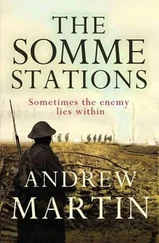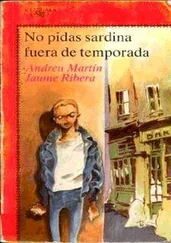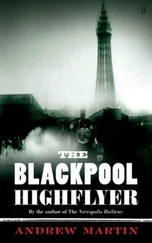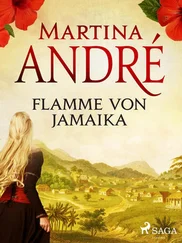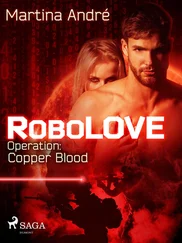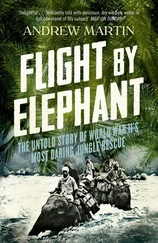Andre Martin - Yotkhee
Здесь есть возможность читать онлайн «Andre Martin - Yotkhee» — ознакомительный отрывок электронной книги совершенно бесплатно, а после прочтения отрывка купить полную версию. В некоторых случаях можно слушать аудио, скачать через торрент в формате fb2 и присутствует краткое содержание. ISBN: , Жанр: Прочая детская литература, Прочие приключения, russian_contemporary, на английском языке. Описание произведения, (предисловие) а так же отзывы посетителей доступны на портале библиотеки ЛибКат.
- Название:Yotkhee
- Автор:
- Жанр:
- Год:неизвестен
- ISBN:9785005338563
- Рейтинг книги:4 / 5. Голосов: 1
-
Избранное:Добавить в избранное
- Отзывы:
-
Ваша оценка:
- 80
- 1
- 2
- 3
- 4
- 5
Yotkhee: краткое содержание, описание и аннотация
Предлагаем к чтению аннотацию, описание, краткое содержание или предисловие (зависит от того, что написал сам автор книги «Yotkhee»). Если вы не нашли необходимую информацию о книге — напишите в комментариях, мы постараемся отыскать её.
Yotkhee — читать онлайн ознакомительный отрывок
Ниже представлен текст книги, разбитый по страницам. Система сохранения места последней прочитанной страницы, позволяет с удобством читать онлайн бесплатно книгу «Yotkhee», без необходимости каждый раз заново искать на чём Вы остановились. Поставьте закладку, и сможете в любой момент перейти на страницу, на которой закончили чтение.
Интервал:
Закладка:
Yotkhee
Andre Martin
Illustrator Julia Khruscheva
Translator and Teacher of English at Nizhny Novgorod State Linguistic University Olga Lukmanova
Proofreader Cynthia Tucker
Translator, teacher of English, School #1, Nadym, YaNAO, Russia Andrei Martinov
© Andre Martin, 2021
ISBN 978-5-0053-3856-3
Created with Ridero smart publishing system
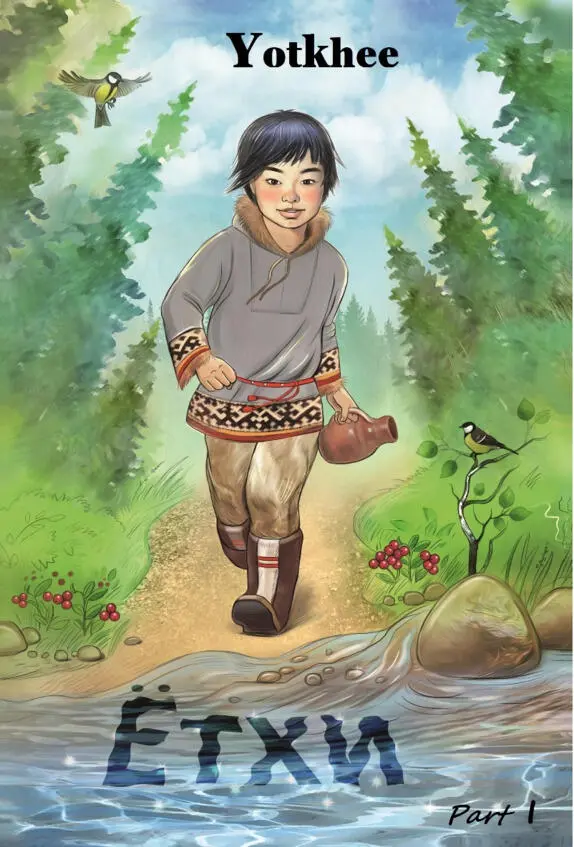
A Tale within a Tale
Part I.
Yotkhee
Foreword
All peoples of Earth have their own myths and legends, their own fascinating cultures, customs, and traditions. In Russia alone (which is the largest country in the world) there are more than 195 peoples or ethnic groups, each with its own language.
Studying all these cultures and languages is always incredibly exciting. It’s like you find yourself in a totally different world or on another planet – because, of course, each ethnic group has its own music, songs, clothes, and ways of life that are different from yours.
In this tale-within-a-tale, the author has tried to show at least some of the most fascinating things about just one of Russia’s many wonderful peoples, hoping that his curious young readers would get excited about their planet’s many nations and ethnic groups, each with its own history, culture, literature, and language, and would become involved in learning more and more about all of this.
To see how very different things could be, take a look at the alphabet of the good people you’re going to read about. It even looks different, doesn’t it? It is very close to the Russian alphabet (which is called Cyrillic), but it’s different even from that, because it has letters for some sounds that do not exist in Russian or in other languages.
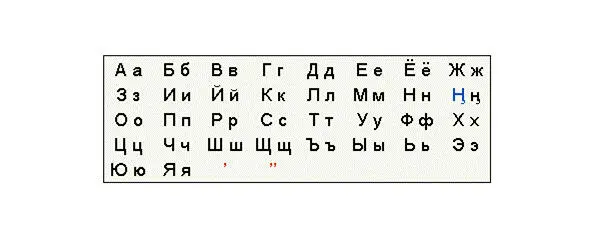
Besides, each culture has something that we all can admire and might even want to imitate or adopt. Which is probably the best way to learn anyway.
Colorful illustrations, made by the artist according to the author’s careful instructions, will help the readers to get a better visual picture and a clearer understanding of what he was trying to tell them.
Happy reading to you all!
«Keep up, Khadko, 1 1 Khadko – a male name.
we have to get back to the camp before sundown!» called the father to his six-year-old son. He pulled their small flat-bottomed ngano 2 2 Ngano (Nenets) – a flat-bottom boat.
out of the water, tied it to the stake driven into the bank, and began to carefully stack the fish they’d caught onto the khan 3 3 Khan (Nen.) – a sledge.
– a large take of muksun, 4 4 Muksun (Nen.) – a type of whitefish.
broad-nosed whitefish, and white salmon: the best that rivers and lakes of this Upper End of the World can yield to reindeer herders. He then sat down on the left side of the khan and grabbed the reins and the khorei, 5 5 Khorei – a long pole for guiding a team of reindeer.
ready to go.
The boy was still on the bank, expertly skipping stones across the water. He didn’t want to leave and go back to the camp. It didn’t often happen that Dad took him fishing or hunting: he was still too young. The day was quiet, with no wind at all, and the orange-colored autumn sun was bright in the vast blue sky.
«You’ll make the spirit of the water angry,» his father called out, when he saw what the boy was doing. «You mustn’t throw anything into the river!»
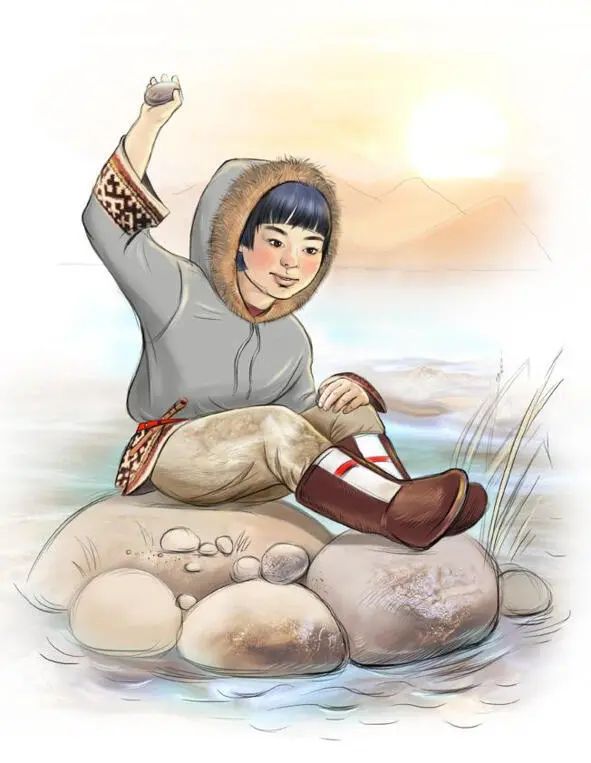
«I mustn’t?» responded Khadko, more in surprise than wanting to know more, and dropped the remaining stones onto the ground.
«Come on, son, let’s go,» his father called again. «Ah, dinner will be great tonight,» he added with a satisfied smile when they finally got going. «Muksun is all large and fat this year.»
Khadko sat on the right side of the sledge, holding on tight to the edges, watching his father’s skillful movements. He was an observant child. The sledge was flying over the tundra, and the handsome, powerful reindeer, like huge fairytale birds, were carrying little Khadko back home, to the camp.
«Vydu’tana 6 6 Vydu’tana (Nen.) – the chief shaman of the highest rank and of the Upper World, according to Nenets beliefs.
is here!» suddenly cried his father, half-rising for a moment when they darted out from behind another tall hill and could finally see their camp with its three teepees. He turned around to the boy, calling loudly again, «Vydu’tana is here, Khadko!»
The boy half-rose on the sledge too, peering into the distance and trying to make out the man his father was talking about.
«How does Dad know that someone has come?» he wondered. «We’re still so far away. I can’t see anyone!»
His father looked at him again, grinned, and artfully guiding the sledge, added in a loud voice:
«You can’t miss the large reindeer and the beautiful sledge of the tadebya! 7 7 Tadebya (Nen.) – a shaman.
Look at how the fur and the hides shine in the sun!»
And indeed, the gorgeous white and gold sledge would be hard to miss even at a distance. It was hand-carved, hand-painted, covered with snow-white deer hides, and pulled by a massive, strongly-built nyaravei 8 8 Nyaravei (Nen.) – a white stag.
with huge white branching antlers, his sleek gilt harness glittering in the bright autumn sun.
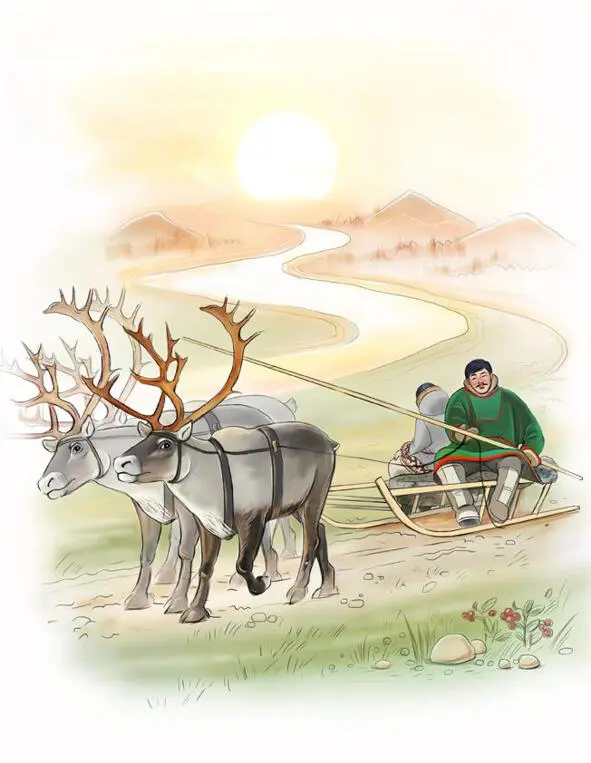
Khadko’s father got up on the sledge and was now driving his team of strong, swift and obedient padvy 9 9 Padvy (Nen.) – piebald reindeer.
standing up. He had to yell to make himself heard over the loud swishing of the air, but his voice sounded happy:
«You know, son, Vydu’tana only visits those who are kind and hard-working.»
The boy knitted his eyebrows slightly and looked pensive. He had once overheard old men talking about a wise teacher who lived on the top of a high mountain in the north of the Urals and sometimes rode around the tundra, stopping at people’s camps to tell children and grown-ups his wonderful stories.
As swift as a khalei 10 10 Khalei (Nen.) – an arctic seagull.
diving for its catch, the sledge pulled up to the first tepee at the edge of the camp, made a sharp turn, and stopped almost instantly. Khadko quickly jumped off and ran over the mossy ground straight to the campfire already circled by children. No wonder! The great wise teacher had come to visit them!
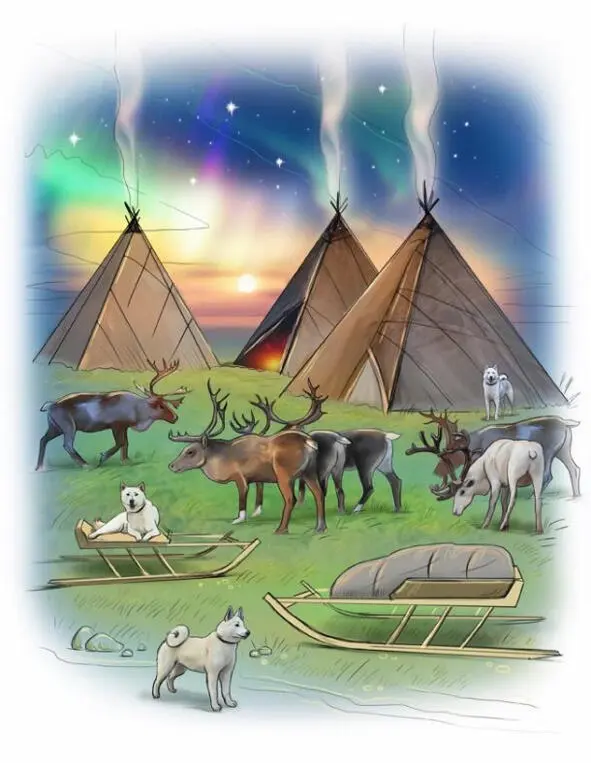
Near the camp’s main tepee, a tall, sturdily-built man was talking to the reindeer herders. He was wearing a clean, white malitsa 11 11 Malitsa (Nen.) – an outer hooded garment for winter made of buckskin.
which in the sunshine seemed to shimmer with all the colors of the rainbow. His long white beard was neatly tucked under a multicolored belt with gleaming bear and wolf fangs hanging from it. There was also a large, slightly curved knife with a horn handle, in a richly decorated sheath inlaid with small gemstones that gleamed and glowed in the evening sun. The guest’s malitsa and kisy 12 12 Kisy (Nen.) – tall winter boots widely popular among the peoples of the Upper North (the Nenets, the Khanty, and the Mansi). They are made of hides taken off deer legs (called «kamus’) and have thick multiple-layer soles.
were covered with intricate, beautifully embroidered patterns, sparkling with even more gemstones of various shapes and sizes. The laces on the white kisy boots were woven out of several multicolored straps of leather, adorned on the ends with small wooden figurines of some unknown creatures.
Интервал:
Закладка:
Похожие книги на «Yotkhee»
Представляем Вашему вниманию похожие книги на «Yotkhee» списком для выбора. Мы отобрали схожую по названию и смыслу литературу в надежде предоставить читателям больше вариантов отыскать новые, интересные, ещё непрочитанные произведения.
Обсуждение, отзывы о книге «Yotkhee» и просто собственные мнения читателей. Оставьте ваши комментарии, напишите, что Вы думаете о произведении, его смысле или главных героях. Укажите что конкретно понравилось, а что нет, и почему Вы так считаете.



